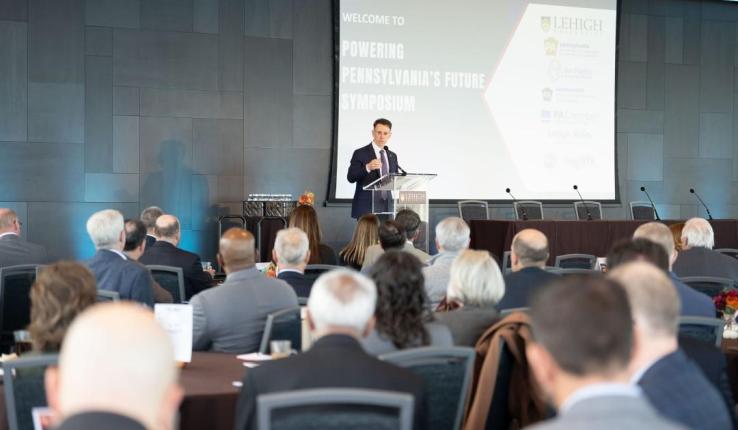Actions Speak Louder than Words

Nandini Deo explores the inner dynamics of both the women's movement in India and the Hindu nationalist movement to illustrate the key elements of effective social mobilization. Pictured here, the founder of the Gulabi Gang, a women's movement whose members take justice into their own hands.
When it comes to mobilizing social change, people are motivated by action rather than ideology, says Nandini Deo.
As part of her doctoral research on the women’s movement in India, Deo, associate professor of political science, set out to learn about how women’s organizations there were lobbying the government. But when she got to India, the lack of existing infrastructure for the groups to use in interacting with those in power caught her attention. Many of the goals of the women’s movement involve government policy and resources, Deo thought, so why wasn’t there any organized lobbying effort?
Thinking it would be useful to demonstrate alternative approaches to influencing politics, Deo decided to also examine the Hindu nationalist movement, which has existed for about as long as the women’s movement but has had a different historical trajectory. Deo’s five years of fieldwork resulted in a book, Mobilizing Religion and Gender in India, which was published in November 2015. In it, Deo employs a historical comparative approach to examine the successes and shortcomings of Hindu nationalism and the Indian women’s movement, both of which have experienced periods of power and irrelevance.
Changing times, shifting power
The women’s movement in India was powerful in the 1950s but has since declined in influence. The movement initially provided services such as girls’ education and economic activities, but with growing trust in the state’s handling of those concerns, turned its focus instead to policy issues. However, in the 1970s, leaders of the movement realized the government was not addressing women’s needs. The controversial 1975-1977 state of emergency declared by Prime Minister Indira Gandhi, which allowed the prime minister to rule by decree, further diminished trust. As a result, the women’s movement distanced itself from political parties and the state as a whole.
“Today [the women’s movement] doesn’t have a particularly powerful influence on most political parties, and because a lot of these groups are competing with one another for funding from large foundations and bilateral aid agencies, they also often find it difficult to work together,” says Deo.
Conversely, in the 1950s, when the women’s movement held power, the Hindu nationalist movement held very little. Having been implicated in the assassination of Mahatma Gandhi, Hindu nationalists were treated as outsiders in mainstream politics. Determined to earn the respect of the public, the group turned its attention to providing healthcare and education. Decades later, these efforts paid off.

“There are a lot of people who have interactions with [the Hindu nationalist] movement that they see as beneficial to them, even though the movement itself has goals that are pretty problematic for most Indians,” explains Deo. “So even though they don’t really agree with the ideology of the movement, their interactions with the individual activists are often positive. I argue that that’s partly why they’ve been able to come back into the mainstream of Indian politics.”
In fact, the Hindu nationalists won a significant majority in a 2014 election.
“They did much better than anyone was expecting, and I think part of the reason they were able to do that is because they have this sort of constant presence in Indian communities,” says Deo. “Even though sometimes among the elite in the party there can seem like there are problems and infighting, that grassroots effort is very strong and is able to keep people connected to the movement.”
Ultimately, says Deo, when it comes to mobilizing support for a movement, actions speak louder than words.
“People want to feel like the person who’s asking them to show up to a protest or a rally is someone who they can trust, somebody that they feel isn’t just using them,” she says. “I think that only comes from having lots and lots of interactions with somebody.”
Broader application
Deo believes the lessons from her research can be applied broadly and might also serve as a means to understanding world politics.
“In some of the politics that we see sort of playing out in other parts of the world, in North Africa, in the Mideast, we see support for relatively right-wing religious parties,” says Deo. “A lot of the reason why they get the support they do is because they are community activists. They provide services that people see as demonstrating that these people genuinely care about them, especially in the context of states that are not being very effective in providing the basics of education and healthcare and so on. I think that kind of appeal is very powerful.
“The big picture story that I tried to tell in the book is that it’s not the ideas of the activists that shape whether people support them or not. It’s what they’re doing day to day,” she says.
Deo’s next steps involve India’s 2013 Companies Act, a provision of which requires all Indian businesses over a certain size to donate at least 2 percent of their annual profits to charity. This corporate social responsibility provision allows businesses to choose the charity that will receive their donation. Deo is exploring how companies choose their recipients and how social movements take advantage of the opportunities presented by the Act.

The Companies Act has the benefit of involving Indian companies, Deo says, so groups receiving funds won’t be accused of being a puppet of the West, a charge often made against women’s organizations.
In summer 2015, Deo and four Lehigh undergraduate students conducted field-work in India, interviewing individuals at some of the biggest companies in India to learn how they are responding to the Act.
“Because it’s new money and these companies are developing new relationships, it seems like a really important time where if you can become a partner with some of these companies, you could assure yourself of long-term, sustained funding,” says Deo. This approach, she says, might be particularly helpful to the women’s movement.
Extending the Conversation
In her book Deo also explores another challenge that Hindu nationalism and the women’s movement present to traditional Indian society—new perspectives on the division of private and public. While Hindu nationalists work to infuse public life with religion, which many consider private, the women’s movement seeks to take matters long held as private—domestic abuse, a family’s unequal treatment of daughters versus sons—and make them public concerns.
An extended conversation about how feminists think about religion and the question of private and public boundaries will be featured in an international, interdisciplinary conference on post-secular feminism at Lehigh in March 2016. Deo serves on the conference committee and will participate in a panel discussion. The conference, “Feminisms Beyond the Secular: Emerging Epistemologies and Politics in the 21st Century,” will include scholars from several different countries.
Nandini Deo’s research interests include comparative politics, South Asian politics, civil society, social movements and foreign aid. Deo received her Ph.D. from Yale University. In her teaching she explores student-centered, project-based, contemplative and collaborative techniques.
Posted on:






